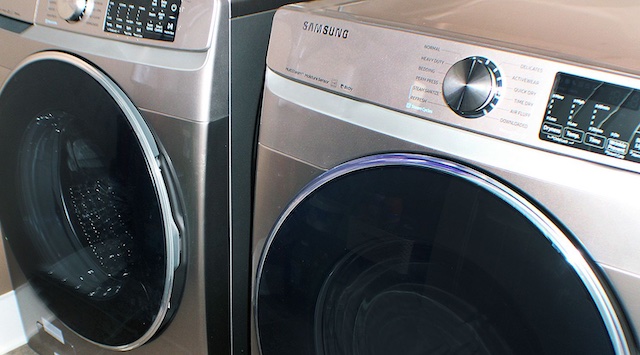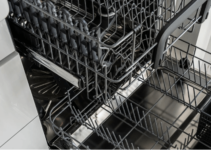Samsung washing machines are reliable appliances, but like every other appliance, they can run into trouble and result in further complications.
If you notice that your Samsung washer is adding time after you’ve already started a wash cycle, you don’t need to get worried as it’s not a defect or appliance malfunction.
Knowing the causes will help in applying suitable troubleshooting methods to solve the problem. Follow along in this article as we provide possible reasons and simple ways to fix this problem and get your washing machine working efficiently again.

Samsung Washer Keeps Adding Time: Likely Causes
Your Samsung washer typically calculates the time required to wash clothes corresponding to the load inside the drum and displays the estimated time accordingly. If it keeps adding time, then something is prolonging the wash cycle. The likely causes are as follows:
- Overloaded Drum
- Uneven load
- Excessive suds or foams
- Faulty water lever switch hose
- Worn-out suspension rod
- Malfunctioning of the Vibrator Sensor.
Samsung Washer Keeps Adding Time: DIY Fixes
From overloaded or uneven drums to excessive suds and faulty components, a lot can happen that can result in your Samsung washer adding more wash time. To fix them, let’s start with the most straightforward likable solutions and work the way up as we attempt to solve this issue on your Samsung Washer.
1. Reduce The Load
Your Samsung washing machine has an “Initial Sensing” or “Load-Sensing.” This feature automatically calculates the time required to wash according to the load weight. So, even though you set a particular time, it adjusts the cycle time and amount of water sufficient based on the laundry weight inside the drum before the cycle starts.
The load sensor is responsible for this feature, and it operates for a few minutes before it adds water. To solve the problem of your washer adding more time, you might need to reduce the amount of load in the machine drum.
Generally, it is recommended you only fill about three-quarters of the machine drum capacity for every wash or rinse cycle.
2. Redistribute the Laundry Weights
Have you reduced the laundry load? Then it would be best if you also spread the load, so they are evenly distributed. This redistribution is necessary because your Samsung washer might keep adding time when it notices an unbalanced load.
If there are too many clothing items piled to a particular side of the drum, the machine won’t be able to spin correctly. Consequently, the Samsung washer will then keep adding more water to the drum or tub to even the clothes out. Your washer will drain the extra water and continue the washing again.
All these processes increase the time needed to complete the cycle. So, ensure you redistribute the clothes evenly to curb this problem.
3. Clear Excessive Suds
When excessive suds are in the machine drum, the clothes will not be washed adequately, and you’ll most likely rewash the clothes. Too much soap foams prevent clothes from being thoroughly washed because it hinders clothes from scrubbing against one another, and it’s the scrubbing that cleans clothes.
If your Samsung washing machine is a new model, it probably has a sensor that monitors the quantity of suds inside the drum. When it detects an excessive amount, it starts a rinse cycle till all the suds are cleared, which uses more water and time.
You have to clear excessive suds in the machine drum to solve this problem, and you can do that with the instructions below.
- Stop your washing machine and unplug it from the socket.
- Remove all the clothes inside the drum
- Manually drain all the water and suds inside the drum.
- Put your machine in a wash or rinse cycle without adding detergent to clear all residue suds.
- Inspect the water hardness properties. If the water is too soft, it can result in excessive suds.
- Put the laundry back inside the drum and restart the cycle.
For subsequent uses, the following tips will help you prevent the problem of excessive suds as it could result in more complications beyond the washing machine adding more time.
- Always use a small amount of detergent. Your Samsung washer is a high-efficiency appliance, and it requires little detergents to function efficiently.
- You can check your user’s manual to know the recommended amount of detergent to use.
- Always use high-efficiency detergents. They have “HE” boldly written on the body.
If the above tips don’t solve the problem, then you’ll do more in-depth tests as explained below.
4. Check Water Level Switch
The machine water level switch sends power from the timer control to the water inlet valve and the temperature switch when the tub requires more water during the wash cycle. The water level switch hose removes the drained water from the drum when the wash cycle is completed.
When the water level switch or its hose is faulty, it can result in an extended wash since the machine will be getting the wrong information about the amount of water left in the drum. Consequently, the machine will think it needs more wash cycles since there’s no clear information about the amount of water remaining in the drum.
To diagnose the water level switch hose, follow the simple steps below.
- Stop the washing machine and unplug the socket.
- Locate the water level switch hose.
- Inspect the hose for any physical damage. If you can’t find any, run water through the hose.
- If there’s any leakage or damage with the hose, you’ll need to replace the water level switch hose.
5. Check The Suspension Rods
The suspension rods’ function is to dampen the movement of the drum and keep the machine balanced during operations. If the rods are broken or faulty, the machine will shake or vibrate unnecessarily, which can lead to a prolonged wash cycle. You’ll need to replace the rods in case there’s a fault.
6. Check Vibration Sensor(RPS Sensor)
The vibration sensor also keeps the machine stabilized during operation. But sometimes, there might be a problem with the sensor wire harness, thus keeping the sensor active and making the machine think it needs more time to complete an unfinished wash cycle.
You can diagnose the vibration sensor as follows
- First, unplug the washing machine and wait for a few minutes to resolve the timing issue.
- Locate the wiring harness of the RPS sensor that connects to the board.
- If the wires are not healthy and look damaged, you will have to replace all.
Lastly, You can also test the sensor and control board for continuity by using a multimeter. If any of them show signs of damage, replace them accordingly.
7. Contact Manufacturer’s Support
Follow the troubleshooting methods we’ve provided in the article to solve the problem of your washing machine adding more time. If the problem persists after trying all these methods, don’t hesitate to contact your manufacturer’s support for further help.

![LG Portable Air Conditioner Not Cooling [Fixed] LG Portable Air Conditioner Not Cooling [Fixed]](https://techrene.com/wp-content/uploads/2022/05/lg-portable-air-conditioner-not-cooling-211x150.jpg)



